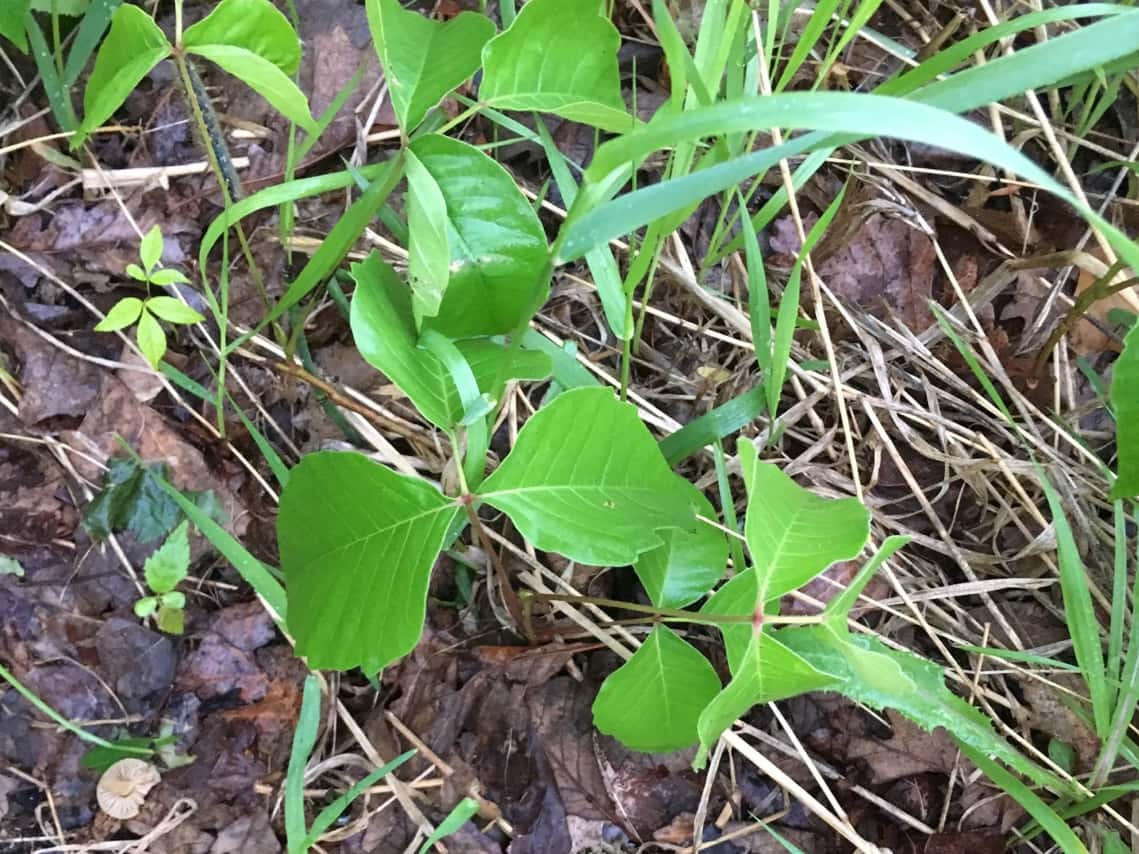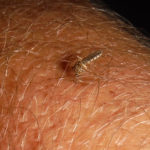
Poison Ivy comes in three-leaved groups, making it fairly easy to identify. Avoid touching it and wash any clothes that come in contact with it immediately after coming indoors. Simonson Photo.
By Nick Simonson
Spring brings with it the first trips out into a greening countryside.
Whether sneaking off to a favorite shore fishing spot or hanging up some trail cameras to catch the first glimpses of a buck caught on a memory card, spring adventures often set anglers and hunters up against flora and fauna that can be challenging. While we’re not exactly talking murder hornets in this neck of the woods (yet), a sampling of pesky plant and insect species should be examined and avoided, or at least warded off, at this time of year.
Ticked Off
While there are a number of tick species, none are more ubiquitous in spring than the wood tick. With its brown body surrounding a smaller white teardrop shape on its back, it is typically easy to identify and poses the least harm of the various tick species to people who encounter it and are bitten. Contrary to its name, the wood tick is more often picked up from low grasses where it resides, awaiting a warm-blooded host to walk by and allow it to climb aboard. Headed for warm areas of the body where blood circulates close to the surface – armpits, scalp and ears especially – the wood tick locks on and begins feeding, often discovered in these areas if it isn’t removed from clothes or while crawling on skin.
The best way to avoid an annoying wood tick bite, which often manifests as a bump similar to a mosquito bite though bigger and possibly more painful, is to keep them from getting under clothes. This means wearing long pants and long-sleeve shirts, preferably lighter in color, to see the darker arachnids on the move across the fabric. Another tactic, especially for extended stints in tick-heavy areas, is tucking pantlegs into socks, or wrapping the point where pants overlap boots with a quick round of duct tape. Even better, reverse the duct tape to form a sticky layer that stops ticks in their climb and can be easily cut off and thrown away with the ticks trapped in place.
Be certain in those areas where the wood tick and deer tick ranges overlap to positively identify any tick that has become attached and monitor the bite location for the tell-tale “bullseye” marking of red rings which may suggest Lyme disease. For any tick bite that gets infected or produces fever or other severe symptoms, contact a doctor immediately.
Poison Distribution
Another springtime surprise that sneaks up on adventurous anglers, whether seeking out secret backwater spots or working along the shady overgrown edges of a stream, is poison ivy. The three-leaved plant typically does well in damp or swampy areas that provide some shade under a canopy of trees. Sometimes sporting a reddish stem and always with three leaves, the plant is often encountered along or near water. While commonly found in stands on the ground that don’t get much taller than shin or knee high, poison ivy can manifest as a vine which can scale trees.
The oil in poison ivy, called urushiol, is an allergen, which in some people can trigger an extreme allergic reaction, though it most commonly manifests as a weepy red rash with yellow fluid. The more skin that is contacted by the oil, the bigger the rash. Avoid weed whacking poison ivy, as the act can expel the oil onto clothes and skin and even into the eyes. Similarly, avoid burning ivy plants or vines, as the oil can be carried by the smoke and inhaled. Rashes can be treated with calamine lotion or other cream which helps cool and dry the affected area. Make sure to wash all clothes thoroughly after coming in from a brush with poison ivy, and scrub areas of skin that may have contacted the plant with soap and cold water, as warm water opens pores and may draw the oil in.

Spring Buzz
Finally, as the first warm nights of spring settle in, it is likely that the buzz of the unofficial state bird – the mosquito – will fill the ear-adjacent air in the boat, on the dock or just in the backyard. Mosquitoes like long grass and damp shady places during the day and come out in full force at night. As with ticks and poison ivy, long pants and long sleeves will keep them from direct contact with skin and a shot of Deet-based spray will also help, just avoid getting the chemical on hands or fish hooks, as it will also ward off fish.
The spread of West Nile virus is notable in the upper Midwest over the last two decades, with cases becoming more common throughout the region and mosquitoes serve as a vector for the disease. While most infections are asymptomatic, about one-in-five develop fever, rash, headaches and vomiting, while rare cases of encephalitis or meningitis can also occur. For these reasons, it’s important to have the physical and chemical repellants in place this spring and summer when mosquitoes emerge.
By properly guarding against these normally minor inconveniences, and being vigilant for any abnormal symptoms, anglers can enjoy the spring season with a few precautions and hunters can venture out to get a look at deer in their area without the fear of spending the season scratching their heads or any other place…in our outdoors.

